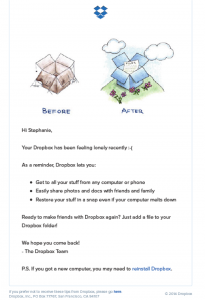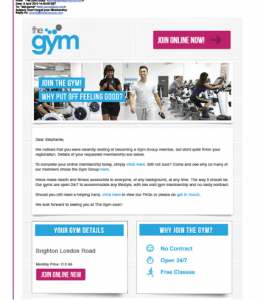Apr
2015
Email Marketing for a small business: Striking the right email tone with customers
 Previously in one of my blogs I made reference to an email I had received from DropBox (in my personalisation blog post), which I believe striked the right tone. It was an excellent example of how companies should address their customers, in a mutually beneficial way that enticed me as a customer, without appearing too pushy or obvious.
Previously in one of my blogs I made reference to an email I had received from DropBox (in my personalisation blog post), which I believe striked the right tone. It was an excellent example of how companies should address their customers, in a mutually beneficial way that enticed me as a customer, without appearing too pushy or obvious.
Here is the example again, and why I thought it was great (picture below)…

- It used my name I had signed up with ‘Stephanie’, as a direct way of capturing my attention that the email was personalised for ‘my eyes only’
- It showcased how to use email personalisation in a mutually beneficial way for DropBox and the user (me), by re-stating the benefits to me, with the hope that this would trigger a behavioural response so that I would once again re-use the service provided (to boost engagement)
- Dropbox’s ability to individually monitor its users
- The email is visually appealing (with minimal text, relevant, yet simple use of images)
The tone is highly effective by adopting an informal and conversational stance, by personifying my dropbox account, stating that it is ‘feeling lonely’ with an emotion ‘:-(‘… This made me want to engage with the content and act upon it.
This example then got me thinking… How can businesses strike the right tone in an email, without sounding too salesy or pushy, thus alienating their customers?… Is there a way for businesses to do this?
The right tone of voice is key to establishing a businesses and the way customers view the business. According to Cummings (2015) a tone of voice is… ‘’not what you say, but how you say it. This encompasses not only the words you choose, but their order, rhythm and pace. Rather confusingly, when seen in the world of business and marketing, the phrase ‘tone of voice’ refers to written – rather than spoken – words. A company’s tone of voice will inform all of its written copy, including its website, social media messages, emails and packaging’’.
Email marketing usually involves using email to send ads, request business, or solicit sales or donations, and is meant to build loyalty, trust, or brand awareness (Mohammadi, Malekian, Nosrati, & Karimi, 2013). But this can all be CHANGED if the tone is wrong. Email marketing, should display a ‘good customer service tone’; by not appearing too pushy or sales focused, with the ultimate aim of building a relationship over time… Emails should be sent to gently ‘remind’ customers of the product or behaviour (Mohammadi, Malekian, Nosrati, & Karimi, 2013). You can also use a blend of soft sale and CTA’s in a single email; e.g., if a customer registered on-site and didn’t return (e.g the Gym email example I mentioned in my email frequency blog post) and ask if they need assistance or encountered a problem, whilst still placing a CTA in an email (Mohammadi, Malekian, Nosrati, & Karimi, 2013).
Newsletters play a large role in keeping constant contact with customers, as part of an email marketing initiative. McGraw (2015) has pin-pointed, depending on the type of company, what type of tone is appropriate and when for business, whether the company is creative or corporate. To read more click this link. McGraw (2015) suggests that small businesses should adopt a casual tone, which is more formal than being ‘conversational’ and not as stuffy as a ‘formal’ approach.
Customers like to know that companies have emailed them because they are a valuable customer, rather than one belonging to a mass of customers. A way in which this can be achieved is by writing in second person. According to Wish Pond (2015) by using words such as ‘’you’’, ‘’me’’ and ‘’us’’ this immediately creates a friendly and inviting tone. As well as this Mohammadi, Malekian, Nosrati, & Karimi (2013) suggest that businesses must adopt a gentle tone, as known as a ‘soft sale’ approach, which are read like a customer service- orientated message. For example, asking the customer if he or she experienced a problem you can assist with is a great way to open lines of communication with a customer who has not logged into his/her account, or made a purchase for some time… much like the corrospondance I received from DropBox. It is also a positive tone to use when re-marketing to a cart abandoner.
It is further suggested by many practitioners that communicating in a B2C format, should use plain language, that is easily digestible and ‘human’. It can be tempting to make things sound more sophisticated than they really are, but the key is to speak to people in a way that makes it easier for them to understand what you’re saying (Grauer, 2013). This creates trust with customers.
When using a casual tone, communication will typically appear to be conversational that usually ignores the traditional use of punctuation, a blogy example is… “Well friends, let me tell ya. The holidays were straight. up. crazy. Ugh! Sorry things went dark on the blog for a while, but I needed a breather. Thrilled to be back, though, and eager to start the New Year with all of you.”
Why this example is positive:
– Acknowledges the audience as ‘friends’ which is friendly and encouraging
– Successfully creates an informal and conversational tone
– Correct tone for the personal blogging platform
However, in saying this. It can be difficult to strike a balance between being friendly and too casual in a communicational or informal casual tone. Grauer (2013) states, that “it’s not a matter of being casual just for the heck of it… It’s speaking in a way that resonates with your audience”. It is therefore useful to seek feedback from customers, to determine whether the tone is being received in a positive way by your audience, and that the messages are resonating and not alienating audiences. This san be achieved through qualitative feedback and email marketing metrics by Vertical Response (Popick, 2013).
Whereas, in a B2B format, it may be more appropriate to use industry jargon, so that businesses appear knowledgable and professional to other businesses.
In every individual business case a company’s tone needs to be inline with their overall strategy and offering, especially when communicating to customers.
Ownings (2012) suggests 4 considerations for ‘finding the right tone’’
1.) Consider your company culture
2.) Don’t be overly familiar
3.) Don’t have multiple personalities
4.) Write like you mean it!
In summary, for small businesses looking to develop their own individual ‘tone’ in email marketing correspondence, they will need to write: in second person, plain easy to understand language, in a customer service orientated tone, and a tone that is consistent with the company and it’s strategy and in a casual tone, that is inviting and friendly.
For a more detailed insight into this topic, visit authors Harriet Cummings work to ”Find your brands voice: How to shape a tone of voice”.
References
Bunskoek, K. (2015) 8 steps to write email copy that converts. Wish Pond [Online] <http://blog.wishpond.com/post/67669286364/8-steps-to-write-email-copy-that-converts> [accessed 12 April 2015]
Cummings, H. (2015) Find your brands voice: How to shape a tone of voice. Distilled [Online] <https://www.distilled.net/tone-of-voice/> [accessed 12 April 2015]
Grauer, Y. (2013) Getting your company’s voice right. Vertical Response [Online] <http://sumo.ly/6gi4> [accessed 13 April 2015]
McGraw, S. (2015) Watch Your Tone: The Importance of Voice in Newsletter Communications. Mad Mimi [Online] <http://blog.madmimi.com/tone-newsletter-communications/> [accessed 12 April 2015]
Mohammadi, M., Malekian, K., Nosrati, M., & Karimi, R. (2013). Email Marketing as a Popular Type of Small Business Advertisement: A Short Review. Australian Journal of Basic and Applied Sciences. Vol. 7 (Issue 4), p786-790
Ownings, P. (2012) Find your tone to increase email marketing conversion. Inbound Marketing [Online] <http://www.inboundmarketingagents.com/inbound-marketing-agents-blog/bid/197191/Find-Your-Tone-to-Increase-Email-Marketing-Conversion> [accessed 12 April 2015]
Popick, J. (2013) 5 metrics every marketer needs to keep an eye on. Vertical Response [Online] <http://www.verticalresponse.com/blog/5-metrics-every-marketer-needs-to-keep-an-eye-on/> [accessed 13 April 2015]
